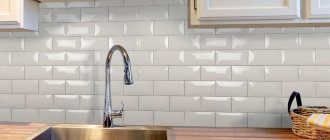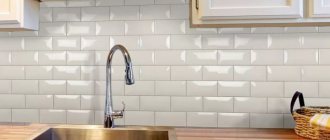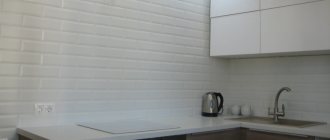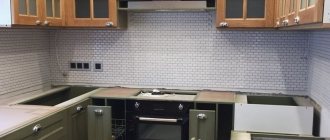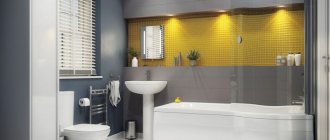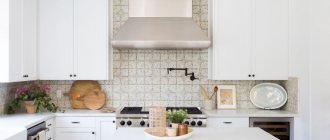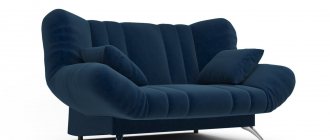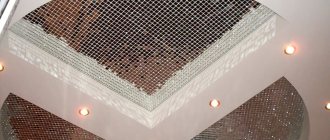The interior of any room consists of many details that should harmoniously complement each other. In the kitchen, one of the important elements is the apron. It is not only designed to beautifully decorate the workplace, but also protects the wall from dirt and other influences.
Boar tiles are increasingly being used for backsplashes. What it is and what interior it fits into, we will find out further.
What is a hog tile
This tile is a type of ceramic small-format rectangular tile. It is laid like a brick. It was originally intended as building facades and was called clinker.
Further, her path went through underground passages, mainly in the subway. That is why in the USA and Great Britain, where they first began to use it for this purpose, they began to call it “subway” tiles. But information about when and who began to use it at home has not been preserved.
Boar tiles quickly gained popularity due to their good quality and amazing similarity to the original - brick. However, it remains a mystery why in Russia it received such a name? All because of the resemblance to a pig's snout. The end, although rectangular in shape, has two holes. At the construction site, they informally began to call her the pig. So the new name for clinker took root among the people and continues to exist.
Types of grout
Color is not the only indicator by which a grout mixture is selected. Manufacturers offer several types of materials, and their features also need to be taken into account. All of them perform a protective and decorative function, but they manifest themselves differently in operation. The seams on the tiles are grouted using the following compounds:
- Based on cement mixtures . A grout consisting of cement and additives (for example, liquid latex) is suitable for sealing joints with a thickness of 1-5 mm; it is elastic and dries quickly. A mixture with added sand is intended for wider joints. It can be white or gray, different compositions vary in grain size.
Large format tiles with contrasting seams Source thespruce.com
- Epoxy mixtures . The composition includes epoxy resin, coloring pigment and hardener, which makes the coating dense, moisture-resistant and, importantly, resistant to household chemicals and ultraviolet radiation. Grout is used for wide (more than 6 mm) joints. Mixtures with the addition of cement are produced; their properties lack chemical stability.
- Silicone . Silicone-based materials are elastic and do not shrink after drying. However, it is better to use them as an additive, since their main property is that they are sealants that protect the base from water. They are not cheap and are suitable for use in wide joints.
Using ceramics of different shapes Source pinimg.com
The advantages of such material
Boar tiles are perfect for a kitchen backsplash. This is due to many advantages of the material:
- Excellent sanitary and hygienic qualities. There is no accumulation or development of microorganisms, and thanks to the solid structure without pores, the tiles do not accumulate dirt, which makes them easy to clean.
- A varied selection of colors and pattern textures. In addition, it can be produced to order, decorated with an individual drawing or photograph. Therefore, the hog fits most interior styles.
- High temperature resistance. When making it, firing is used at about 1000 °C, so the tile is definitely not afraid of elevated temperatures from the stove.
- Simple installation technology that does not require expensive tools.
- The material is harmless and environmentally friendly , does not emit gases and does not cause allergies.
Boar tiles have almost no disadvantages. The only thing that can be noted is the relatively high price and low impact resistance.
Colors
The most popular color for boar is white, and the texture is glossy. It occurs most often, which means it has already become boring and does not evoke the former delights. A good and stylish solution would be to use a colored boar. The tiles can be made the same color as the kitchen interior or, conversely, play with contrast . Universal, but not flashy solutions would be cream, beige or gray cladding.
If you want brightness, you can experiment with other colors:
- green - suitable for country-style kitchens and country houses;
- shades of blue, light blue and emerald will attract all attention to the apron and add freshness to the interior;
- red and yellow will add brightness, but the rest of the kitchen is best kept in neutral colors.
There is a boar with various decorative effects, for example, made in metallic. This option will look relevant in kitchens in a modern style. For such premises, a black matte hog would be relevant. It will require a little more care, as the matte finish may leave streaks after cleaning the tiles.
Don't forget about the impressive properties of white. It maximizes space, which is essential for small kitchens. In such cases, you should take a closer look at the light colors listed above: beige, cream, gray. They will create a cozy atmosphere, and the room will become visually larger.
What style does a hog tile apron go with?
These tiles are perfect for most styles, especially if they are white or beige. It will be ideal for country, Provence and classics. The first two styles are rustic, characterized by simplicity and naturalness. A small brick will only add originality to the design and complement it with the spectacular appearance of the apron.
The classic is the presence of massive wooden furniture. The entire interior is filled with nobility, with clear, simple lines and images. The boar will only add even more aristocracy, especially when choosing light colors.
The tiles will be an ideal solution for Scandinavian or loft style. It is also often used in art deco. An unusual layout is relevant here, contrast is allowed. Including bricks can be black and white and placed in a checkerboard pattern.
It is worth taking into account all the features of the chosen style. A glossy surface is not always suitable. Most often they use matte, which will fit even more into the interior of the above design directions.
Advice! If you want to make your apron bright, then you should take a closer look at Spanish manufacturers who present a wide variety of rich shades to the market.
Choosing between black and gray
It seems that the difference between black and gray is small, but in fact, it is very noticeable to the eye. Which grout should I choose?
Black is used only if there are other objects of this color in the kitchen, for example, a countertop. This rule also applies to the bathroom: black seams are only welcome if the color is found in the interior, for example, on the floor.
Otherwise, there is a possibility that the masonry will begin to stand out too much and “cut” the wall or floor.
Black and white grout options for hog tiles.
Gray color is considered more neutral and multifunctional, so its duplication in the interior is not necessary. But if it is made in the form of curtains or at least a set of dishes, then the interior will instantly become more stylish.
Layout options
- Horizontally in a running start. This is a traditional brick-like layout. It is the most versatile and easiest to implement. The main task here is to position it in a perfectly even horizontal line.
- Horizontal stackable. The main thing here are the vertical seams, which must coincide with each other. This is an ideal proposal for the Scandinavian style. Moreover, you can choose a grout of a different color from the tile.
- Herringbone. This arrangement is at an angle of 45 or 90 degrees. It looks original and will not taste trivial.
- Diagonally. This option is also quite unusual and is suitable for small kitchens. Here it is important to choose a grout that matches the tone of the tile.
- Vertical with offset. This option is suitable for spacious rooms. The tiles should be chosen in a small size.
- Vertical stackable. In this case, the installation must be done as perfectly as possible, then the look will be very stylish and original.
What types of installation are there?
A traditional “subway” apron imitates a brick wall, so it is most often placed in a spaced pattern with different offsets or “seam to seam” (pictured on the right). In the latter case, the emphasis in the design of the apron is on the seams, so most often the grout is chosen in a contrasting color, and the seams themselves are made very neatly and evenly.
How to choose grout
Just like tiles, the variety of grout colors gives you something to think about. You can choose white, black, gray, beige, or you can match it to the tone of the tile itself. In any case, the most important thing is that it is of high quality, otherwise it will quickly darken.
The water resistance of the material is important, since the apron often gets dirty and needs to be washed, and resistance to temperature changes is also necessary.
Advice! To avoid darkening of the seams, it is recommended to purchase a mixture based on epoxy resin. It does not absorb water and dirt, but hardens very quickly. Therefore, in this case, the laying should be done by a professional who will do it as quickly as possible.
Advantages and disadvantages of dark seams
To accurately determine the choice of grout color, you need to compare all the pros and cons of black joints on a white background.
| Advantages | Flaws |
| Looks stylish, modern | Not suitable for any interior |
| Draws attention to the interior and to the tiles themselves | Draws attention to errors during installation |
| Maintains a presentable appearance much longer | May look gloomy |
| The design looks more original |
An excellent example is the combination of light hog tiles and dark grout.
Styling tools
The hog finishing tiles are installed according to the principle of conventional ceramic tiles. To do this you will need the following tools and materials:
- Drill with kneading attachment and container;
- Rubber or plastic spatula, preferably flexible;
- Rubber mallet;
- Small construction float;
- Spatulas with teeth;
- Soft sponges and rags;
- Sharpening machine, tile cutter;
- Marking tool;
- Screws for fastening the profile;
- Metal or wooden profile;
- Tile adhesive, grout, water.
Which style is best to use?
The variety of designs of hog tiles for the kitchen allows you to choose a solution that is harmonious with the interior of any style.
Note: some delicate designs in tandem with “brick” decor will change the orientation towards the loft. You should not expect airiness and lightness from an idea borrowed from façade decoration.
In terms of styles, a “brick” apron is typical for modern, industrial, loft, and scandi kitchens.
Modern trends in loft design call for a departure from the classic canons of white glaze, choosing mouse or ivory for masonry in combination with soft lighting.
Preparatory work
Before you begin installing the tiles, you must carefully prepare the surface so that it is smooth and free of flaws. First of all, you need to get rid of the old surface, such as wallpaper, paint, and remove all dirt. Next you should apply putty and level the walls with it. It must dry, after which a primer is used.
The next step is marking. Here a marker, upholstery cord, plumb line, and building level will come to the rescue. First, the lower horizontal line is applied, the height of which depends on the height of the furniture. Depending on the installation method, the remaining lines are applied horizontally, vertically or at an angle. Finally, the profiles are attached to the wall.
Apron design
A kitchen apron, lined with a hog pattern, can stretch along a corner or occupy the entire wall. Depending on the area allocated for it, various types of coatings and additional decor are selected.
If the set occupies the entire wall, it is recommended to use glazed products. The glossy finish effectively reflects light, visually expanding the space.
Hog with a matte finish is less common. It is used in interiors where gloss is stylistically inappropriate, or in kitchens with an abundance of shiny surfaces.
The photo shows a black kitchen, the glossy apron of which is favorably illuminated by built-in lamps.
The hog can easily be combined with other tiles, for example, when you need to highlight the area between the stove and the hood. The mosaic, inscribed in the apron with a thin strip, looks harmonious.
The photo shows a small kitchen, decorated with an emerald-colored apron and patterned tiles in the stove area.
You can also combine different colors and layout methods.
Apron installation
Installation work begins with mixing tile adhesive. This is done immediately before laying. The volume of glue should be such that it can be used for no more than 40-50 minutes. It is applied both to the wall and to the tiles themselves using a spatula.
Next, you need to make stripes with a notched trowel. There is no need to apply all the glue to the wall at once. There is enough volume for 2-3 slabs so that it does not start to dry out.
Immediately after application, work moves on to laying the first row. You should start from the far corner in relation to the entrance to the kitchen. The bottom edge of the tile should rest against the profile. It must be pressed against the wall. Crosses are placed between the elements, which serve as a separator and ensure an equal distance between each hog. Remaining glue is removed no earlier than an hour later. This also applies to crosses.
Briefly about the main thing
The choice of grout plays an important decorative role in creating the design of a kitchen or bathroom. Its color affects the perception of the tile, which is especially true for white tiles. There are different types of grout mixture, and their characteristics must be taken into account when choosing a material.
In the design of the bathroom and kitchen, combinations of white tiles with white, gray and black grout are used. Most often, the seams are made white; This is a classic, proven and attractive option. Gray joints will help soften the tile pattern or emphasize the original layout. The contrasting white and black option is difficult to ignore; it is used to create an accent in some styles.
Grouting joints
The glue must dry completely and only then, approximately the next day, the seams are sealed. Apply it with a soft plastic spatula. Black rubber is not suitable in this situation, as it leaves marks on the ends.
Excess material can be removed after 30-40 minutes. A sponge is used for this. After complete drying, the apron is completely washed and polished, and the profile that was intended for supports is removed.
Suitable interior styles
Most often, such tiles are used in modern interior styles, because they fit perfectly with them.
- For example, white hog tiles are very popular in minimalism and high-tech.
- In styles such as Scandinavian and modern, tiles are also very popular due to their characteristics.
It is worth noting that in some styles, not only the apron is laid from this tile, but also individual walls. As a rule, work walls in the kitchen, near which they prepare food, are excellent for this.
However, you should not get too carried away with this material, because it can simply spoil the main idea of the style and interior as a whole.
Useful tips
Tiles must be purchased with a reserve. It is about 10%. It always requires pruning, as a result of which part of it gets damaged. Before laying it is very important to level the wall, otherwise due to unevenness it will be difficult to lay out the tiles without flaws.
In addition, the service life of the hog directly depends on this preparation. The seams must be perfect, so it is better to trust a professional, especially if the layout is unusual.
It must be remembered that convex tiles are thicker and therefore heavier. Therefore, it must be attached more carefully, applying a larger layer of glue for standard material. The seams should be between 2 and 5 mm thick. Of course, the thicker it is, the better the look, but in this situation the complexity of the work increases.
Thus, boar tiles have won their rightful place in the kitchen interior. An apron made of this material has an attractive appearance, the originality of which depends on the laying of these bricks.
In addition, the material is very easy to wash. It is interesting that the seemingly soiled white color in this case, on the contrary, will be advantageous. This is because stains, possible drips and drops of water are invisible on such tiles. They are very easy to wipe with a regular damp cloth.
Regarding design, it is important that for any style it is possible to choose suitable hogs that will complement it and give the desired atmosphere. Manufacturers provide a wide selection of colors and patterns that are sure to suit any kitchen.
Textures
The first thing that catches your eye when looking at a tile is its texture. The most common type is boar with a smooth, seamless texture. In such cases, they try to keep the seams between the tiles minimal to make them easier to maintain in the future.
Rarely do they use a hog made from marble. This solution is more relevant in the bathroom than in the kitchen. Although the pattern can hide dirt from the stove or work area, it is difficult to fit it correctly into the interior.
Another division of this tile is its volume. The boar can be convex or flat.
Convex models are accompanied by bevels along the edges. They can be of different widths and depths. There is no big difference in terms of practical convenience between these options, but cleaning flat tiles is a little easier. But the difference is so insignificant that this decision should be made only based on taste impressions and the interior of the room.
For a kitchen in a country or classic , a convex hog with a rounded edge is suitable.
Flat tiles will look good in a modern interior in a minimalist or loft .
Boar tile for kitchen backsplash photo
Laying features
Boar tiles look great only if they are installed carefully and professionally. An important component of the visual effect is smooth, clear seams. Therefore, it is better to entrust the laying of tiles to a professional.
If you are quite confident in your abilities and have already done tile work before, then a few tips will help you figure out how to beautifully lay hog tiles:
- You need to buy tiles following the rules for buying regular tiles - +10% on trim;
- Wall preparation plays a very important role. The wall must be perfectly flat, grease-free and dry. Additional priming will not hurt;
- To get even seams, it is not enough to use one cross. You will need a laser level with which you can apply marking lines on the wall;
- Convex tiles are thicker and heavier than conventional ceramics. Therefore, you need to increase the glue consumption and apply the composition to both the tile and the wall. This will improve grip;
- The permissible seam thickness is from 2 mm to 5 mm.
The most difficult part when laying out is forming a beautiful angle. Tiles can be cut into corners at 45 degrees. Such a joint will look neater. You can simply cover the joint with a plastic or ceramic corner to form a closed corner. If the tiles are laid staggered, and you need to trim them for a corner, then it is better to turn the trimmed side towards the row, and bring the straight, uncut side to the corner.
It is more difficult to install sockets and faucets on the convex surface of the hog. They need to be mounted along a horizontal seam, choosing the position in such a way that the edges of the equipment do not fall on the chamfer, otherwise a not particularly beautiful effect of hanging in the air will be created.
What sizes of the “hog” are there?
The boar tiles have different sizes. They range from small 7.5X10 cm for interior spaces to significant 200X100 for cladding building facades. The size in demand when decorating sanitary premises and kitchen areas is 10X20 or 30 cm. Below is information about the manufacturers of these products and the main sizes of tiles in their collections.
| Manufacturer (collection) | Main tile format |
| Biselado | 10X20; 5X15; 10X10. |
| Blanco | 10X20; 10X30; 7X15. |
| Brick | 90Х60; 10X20; 75X150. |
| Brillo | 5X15; 10X20; 60X30. |
| Caprichosa | 10X10; 5X15; 7X15. |
| Equipment | 10X20; 10X30; 7X15. |
| Kerama | 5X15; 10X20; 60X30. |
| Mainzu | 200X100; 90Х60; 75X150. |
| Marazzi | 10Х20;5Х15; 10X10. |
| Metro | 10X15; 15X40; 7.5X15. |
| Monopole | 5X15; 100 X 200; 75X150. |
| Vainilla | 5X15; 10X20; 60X30. |
| Vives | 10X15; 15X40; 7.5X15. |
Advice! For finishing small rooms or local areas of the interior, it is better to use a small hog. If the wall surface area is significant, then a beautiful look is achieved with large tiles.
